Microsoft BUILD: Windows 8, A Pre-Beta Preview
by Brian Klug & Ryan Smith on September 13, 2011 12:05 PM EST- Posted in
- BUILD
- Windows
- Microsoft
- Windows 8
- Trade Shows
Mobile Experience Side
Coming from the smartphone side of things, I really see many shades of WP7 inside Windows 8. That’s actually dramatically understating the state of things - the core of what we’ve been shown of Windows 8 that’s new literally is either adopted from or directly analogous to much of WP7.
It doesn’t come as a surprise to me at all that the desktop Windows experience is moving in this direction, (and it seems as though the Xbox 360 interface will follow shortly). The positive result is that Windows 8’s touch experience feels much closer to the ground-up approach Android Honeycomb or iOS have taken than the than the “Tablet-Edition” versions of Windows XP and the tablet integration in Vista and 7. I used a UMPC and remember Origami and how that application lived as its own standalone mode of operation as an application within windows. What Windows 8 is the inverse - Windows now lives inside a Metro-themed Start screen that looks like WP7 for the desktop. Or at least it does in this demo we’ve been shown currently.
The tablet experience is now absolutely on par with modern mobile OSes - sure there are a few more things that need to be included, but the foundation is there for Windows to suddenly become more than an OS that also can do touch-based interaction.
IE 10
Microsoft has been actively promoting IE 10 since MIX 11, with two platform previews so far, and IE 10 is an integral part of Windows 8 both as a browser and as a runtime for HTML based Metro applications. We won’t go into exacting detail about what’s new and interesting inside IE10, beyond mentioning that it improves upon IE 9’s GPU acceleration and improves web compliance support including CSS3. What’s relevant in Windows 8 is that IE 10 gets two views - one belonging to the Metro-heavy start menu experience, which we’ll call the mobile view, and the other belonging to the traditional desktop windows view.
This dichotomy exists between the two IE10 experiences, which is in itself a bit curious. The mobile view is almost exactly what IE looks like inside Windows Phone 7.5 - at the bottom is the URL bar and controls, and with a slide down gesture, at the top are tabs. Meanwhile the IE10 desktop experience uses the older IE 9 UI. At this point, it doesn’t appear that windows opened in one are transportable to the other.
The mobile view is almost exactly like WP7.5’s however, the URL bar disappears when scrolling, and the browser supports a completely fluid multitouch experience that feels speedy.
Cloud
Windows 8 offers considerable integration with Windows Live and SkyDrive. Local user accounts can be directly tied to a Live account on trusted PCs, and then be used for live roaming. Live roaming enables each connected device to access the same set of accounts for photos, email, calendar, and contacts and speed up initial setup. For example, photos captured on a WP7.5 device’s camera roll can be immediately visible on a Windows 8 PC authenticated against the same Live account. This is very close to how camera roll will integrate into Apple’s iCloud and synchronize across iOS and OS X Lion.
One thing is clear, and it’s that Microsoft plans to heavily integrate and leverage its Live services into Windows 8 and provide an ecosystem-wide way to migrate accounts settings, photos, and data between mobile, tablet, and desktop.
Samsung’s Reference Tablet
We’ve been loaned Samsung tablets running the Windows 8 Evaluation copy used for this article, and thought it bears going over since the device will no doubt become a reference platform for Windows 8 development. This hardware is also being given away to developers in attendance at BUILD as well.
The Samsung tablet is none other than the 700T model announced at IFA very recently, and it packs a relatively impressive spec list.
| Samsung 700T Windows 8 Development Notebook/Slate - Specifications | |
| Processor |
Intel Core i5-2467M (2x1.6GHz + HT, 32nm, 3MB L3, 2.3GHz Turbo, 17W) |
| Chipset | Intel 6 series |
| Memory | 4 GB DDR3 1333MHz RAM (1 SODIMM) |
| Graphics | Intel HD 3000 |
| Display | 11.6" Super PLS (1366x768) |
| Hard Drive | 64 GB Samsung SSD |
| Networking | 802.11n WiFi + Gigabit Ethernet + GSM/WCDMA HSPA+ |
| Sensors | NFC, Magenetometer, Accelerometer, GPS, ALS, Front, Rear Camera |
| Dimensions | 12.9 mm thick, 909 grams |
The 700T includes GSM/WCDMA cellular connectivity courtesy of an Option GTM661W combination cellular modem and WiFi card. The GTM661W uses a Qualcomm MDM6200 baseband, which also provides GPS. There are also sensors such as ambient light, an accelerometer, and the two cameras onboard.
In addition, the 700T includes an active digitizer and capacitive touch display, making it suited for all three interaction modes that Windows 8 will support. The device comes with a dock that doubles as a charging stand, and also replicates full size HDMI, GigE, and a USB 2.0 port on the back. The slate has one USB 2.0 port, a headphone jack, microSD card slot, SIM slot, and a rotation lock button.
Samsung calls the 700T a slate, we've elected to call it a tablet, and the device feels decent if not a bit heavy in the hands. The 700T is also the first 16:9 tablet we've seen, with Android adopting 16:10 and iOS going with 4:3, which makes portrait a bit extreme.


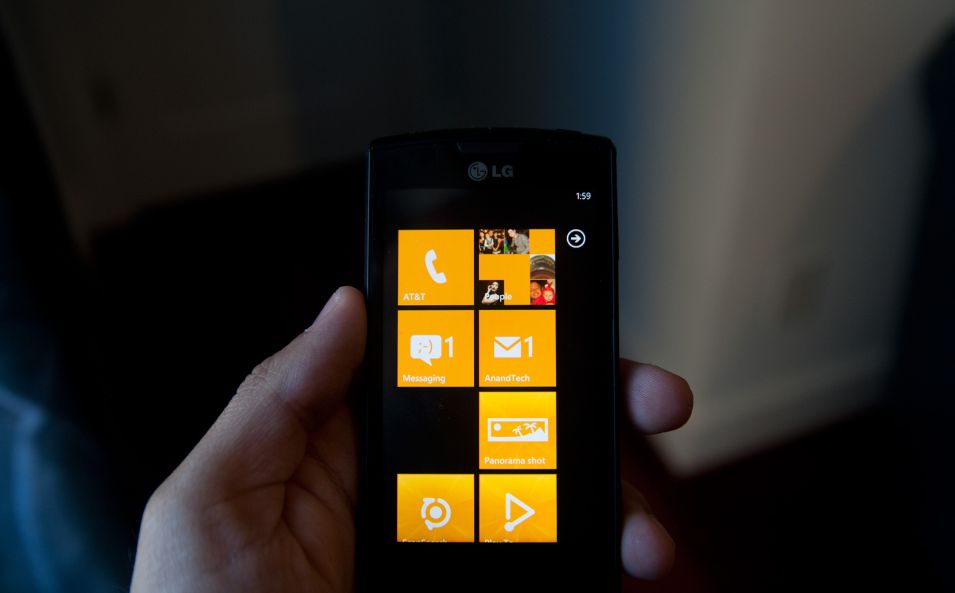
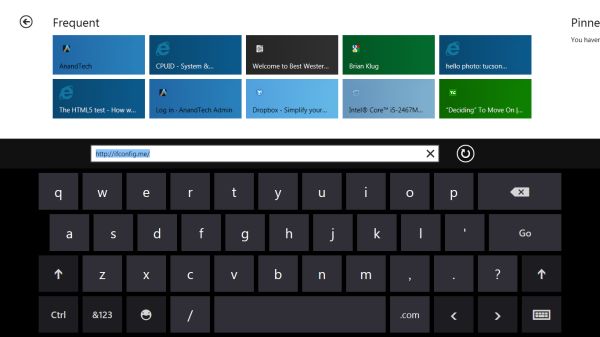
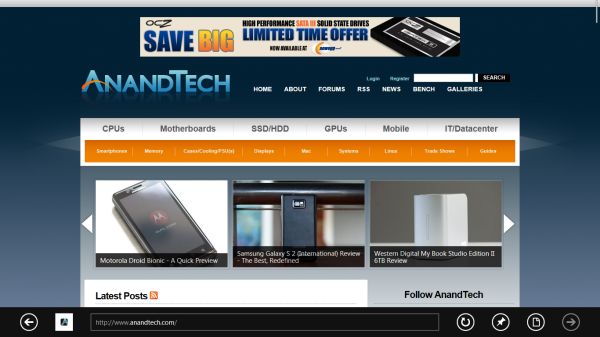
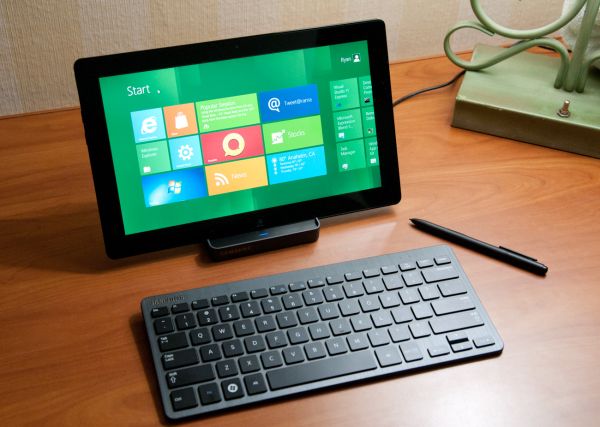
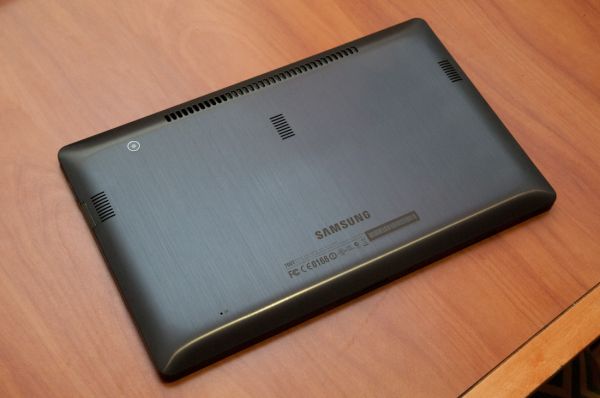
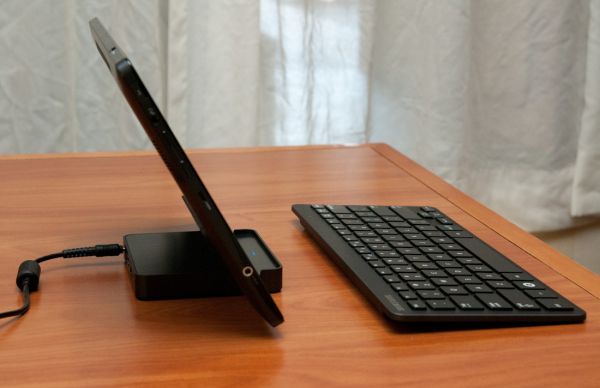








235 Comments
View All Comments
Booster - Thursday, September 15, 2011 - link
It's the ribbon again, but infinitely worse. Metro is just outright stupid, that is.I remember watching a presentation by Julie Larson-Green where she pitched the ribbon back in 2006. IIRC she said that they listened to the users and created the ribbon according to their usage scenarios. So according to her the ribbon was next best thing since sliced bread.
Who were they listening to? The ribbon looks better give or take, but it's less useful in the workflow, it's less effective, it's just plain worse than the old concept. That division of MS doesn't listen to users, it's like a dictatorship in which we have to use our PCs the way that madam wants us to. But she doesn't do any actual work on the PC like me for example. Hell, you can't even preview a page or print without setting up the ribbon, where's the usability? Why do I have to scroll between all those damn tiles?
This Windows 8 fiasco is where MS finally needs to realize the situation and finally take the matters well in hand.
archer75 - Thursday, September 15, 2011 - link
You do realize you don't have to use the metro tile UI right? You can boot right in to a traditional desktop like you are used to.Plenty of updates here for the desktop user.
Really this new metro UI just provides a better layer for tablets but the OS is still there which i'm really pumped about. I don't know how often i've been using my ipad and wishing I could access a real OS on it.
Moricon - Friday, September 16, 2011 - link
"Overall Windows 8 is extremely jarring right now from a desktop user perspective. Metro is the Windows shell, no ifs ands or butts. Metro applications can only be accessed through the Metro shell (i.e. the Start Screen), and the Metro shell is always what the tablet will boot up into. Explorer as we know it is the Metro shell – if you kill it, you kill Metro shell with it – so at this time it’s not possible to boot up into the traditional Windows desktop. Even if you could, the Start Menu is gone, replaced with Metro charms."Metro IS the windows Shell--- METRO IS EXPLORER!!!!
Have you loaded the build, I have, played with it. IT SUCKS bigtime!
Microsoft will go back on this, the pressure will be to great from the desktop user!
There are improvements, better memory management, faster boot process, safer recovery options, faster work-flow (yes ribbon is actually better for non-power users, who use keyboard shortcuts.)
Why can they not just bring those improvements to th Win desktop version and leave metro to Tablets, Netbooks and ARM anyway.
My days of PC Gaming are coming to a close, most Games are crap! Looks seriously like Mint will become my main Work OS and I will keep a copy of WIN7 for my back catalog of games!
MrBungle123 - Friday, September 16, 2011 - link
How is this Metro crap going to work for those of us that make a living with a mouse and keyboard?I work in IT, I have to do everything from assisting users to writing programs. Its not uncommon for me to have Visual Studio, Outlook, IE, 2 databases, and 5 or 6 Remote Desktop connections going on at the same time.
There is no way in hell I'm putting this garbage on my work computer, nor am i going to install it on any of the desktops/servers connected to my network. This is a user training nightmare, the resistance to migrating to Vista from XP is nothing compared to what the resistance of migrating from Win7 to Win8 will be if the final product is anything like this.
talk2dfox - Friday, September 16, 2011 - link
Does anyone else think Windows 8 seems to have no coherent strategy?For users:
1) two different types of applications, which can't run side by side: what do you do if you are a business user who needs to switch efficiently between one application which is Metro-based and another which is not?
2) switch to the desktop and click on the start button and you're back at the Metro UI? huh? Are the only desktop applications I can start directly from the desktop UI the ones which have links on the desktop?
3) some settings are in the metro control panel, others in the old windows control panel
4) too many gestures which will be impossible to remember because they bear no relation to anything you've used before. The whole reason why the touch experience of iPhone et al has caught on (and why even small children catch on to it quickly) is that it is familiar. Want to move what's currently on the screen up? put your finger on it and move it up as if it were a physical object. Want to zoom? use two fingers to "stretch" or "shrink" the image. So, what's the comparable analogy in Metro for swiping up to select a button? There isn't any. Not that Microsoft had much choice - they're trying to graft a touch experience onto an existing Windows UI which has too many different functions without physical analogies, so some of them are bound to be mapped to something weird. But that's the point - trying to graft a touch experience onto the existing Windows UI is never going to produce something coherent and intuitive.
For developers:
5) yet another API, but all the old APIs (.net and win32) still supported (but only on x86, not ARM).
6) If you are starting to develop an application today, what should you use?
Will an app built for Windows Phone 7 today be portable to Metro (and sellable via the Windows 8 store)? If not, will it run at all on an ARM-based metro phone or tablet? What about an x86 based tablet or desktop?
What if you want to write an application to be used on Win 8 on all form factors? The only thing which will run on Win 8 on ARM will be Metro, but the development tools for Metro don't exist yet. Think about how far WP7 is behind iPhone and Android today, and then consider what the situation will be like for Win 8 which is just now reaching the point where Microsoft can demo the UI and talk about development.
Contrast this situation with iOS/OS X: With a single language (objective C), a single development environment (xcode), and two variants of essentially the same framework (Cocoa), you can target iPhone/iPad and Mac.